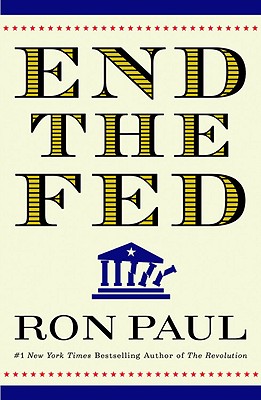End the Fed
Ron Paul

I picked this book up because I know that it gives voice to feelings that a lot of Americans share, and I thought it would be worth trying to understand that movement.
When I started this book, I at least respected Ron Paul for being consistent–he not only opposes the Fed and other “liberal” government programs, but also conservative centerpieces like the invasion of Iraq. But as I read this book, one of the main things that jumped out at me was his inconsistency on economic matters. He poses as taking a hard conservative line on everything–not only is he opposed to the Fed, but also to the FDIC and even the existence of fractional reserve banking (which is a necessary precondition to the bank runs against which the Fed and FDIC are supposed to protect). He says that financial institutions should be separated into custodian-type banks, that basically hold your money under the mattress, and investment-conduit type entities without demand deposits. That way, everyone investing in the conduits would be aware that their money was at risk, and if a custodian bank failed, it would be prosecuted for fraud. First, I think that Paul underestimates the level of regulation that would be needed to enforce these rules. Indeed, fractional-reserve banking is a free-market invention and it is strange that Paul, the self-styled free-marketeer, would oppose it. Second, I think Paul vastly underestimates the desire of the average saver for a risk-free savings vehicle and for demand deposits. Under Paul’s system I would expect a near-complete depletion of the supply of funds available for credit, massively restricting the funds available for investment.
It also strikes me as odd that self-styled free-marketeers like Paul support the gold standard so strongly. After all, setting a conversion rate between gold and dollars is identical to government fixing of the price of gold–not exactly a free-market idea. What’s more, I imagine Paul would like all countries to be on a gold standard, which is equivalent to saying that all exchange rates should be fixed, again by government fiat. These inconsistencies are apart from all the other ludicrous outcomes that would result from maintaining the gold standard, such as the fact that if another country were able to steal our gold reserves our currency’s value would go to zero immediately, or that the level of gold production would be the (completely arbitrary) determinant of the money supply.
Overall Paul’s book is in the classic style of Austrian economics. It is devoid of empirics and relies completely on logical syllogism. Many of these syllogisms appear superficially sensible but in fact rely on extremely problematic premises, such as the very common analogy of the government budget to a personal budget. It relies on fuzzy semantics and conflation of different issues. The main example of this is the definition of the term “inflation”. Mainstream economists define this as the rate of change in the aggregate price level–you can debate exactly how to measure this, but the consensus is that the concept is reasonably well-defined. Paul and other Austrians, though, insist that the “real” definition of “inflation” should simply be the rate of change in the money supply, abstracted from any effect on prices. This allows them to draw a very strong connection between central banks and the existence of inflation, but then they turn around and discuss the pernicious effects of inflation on the consumer, implicitly reverting back to the standard definition of inflation (after all, how does the aggregate money supply impact the consumer if not through price levels?). Finally, and most frustratingly, Paul takes the classic extremist’s position that no historical fact can serve as a counterargument to his position, because his position is so extreme that it has never actually been implemented in reality (and never will be). Thus he dismisses the massive financial panics of the nineteenth century with a wave of the hand.
Don’t mess with my job, Ron.